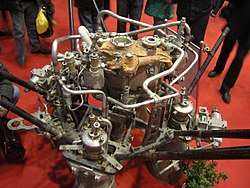YF-73
The YF-73 was China's first successful cryogenic liquid hydrogen fuel and liquid oxygen oxidizer gimballed engine. It was used on the Long March 3 H8 third stage, running on the simple gas generator cycle and with a thrust of 44.15 kilonewtons (9,930 lbf). It had four hinge mounted nozzles that gimbaled each on one axis to supply thrust vector control and was restart capable. It used cavitating flow venturis to regulate propellant flows. The gas generator also incorporated dual heat exchangers that heated hydrogen gas, and supplied helium from separate systems to pressurize the hydrogen and oxygen tanks. The engine was relatively underpowered for its task and the start up and restart procedures were unreliable. Thus, it was quickly replaced by the YF-75.[3]
 | |
| Country of origin | China |
|---|---|
| First flight | 1987-01-29 |
| Last flight | 2000-05-26 |
| Designer | Beijing Aerospace Propulsion Institute |
| Manufacturer | China Academy of Launch Vehicle Technology (CALT) |
| Associated L/V | Long March 3 |
| Successor | YF-75 |
| Status | Retired |
| Liquid-fuel engine | |
| Propellant | Liquid oxygen / Liquid hydrogen |
| Mixture ratio | 5.00 |
| Cycle | Gas-generator |
| Configuration | |
| Chamber | 4 |
| Nozzle ratio | 40 |
| Performance | |
| Thrust (vac.) | 44.15 kilonewtons (9,930 lbf) |
| Chamber pressure | 2,590 kPa (25.9 bar) |
| Isp (vac.) | 420 seconds (4.1 km/s) |
| Burn time | 800 seconds (13 min) |
| Dimensions | |
| Length | 1.44 metres (4 ft 9 in) |
| Diameter | 2.2 metres (7 ft 3 in) |
| Dry weight | 236 kilograms (520 lb) |
| Used in | |
| Long March 3 H8 third stage | |
| References | |
| References | [1][2][3][4] |
History
In October 1970 the Beijing Aerospace Propulsion Institute was tasked with developing a 39 kN (8,800 lbf) prototype rocket engine burning liquid hydrogen and liquid oxygen. They settled on a pump-fed gas generator design. The prototype was successfully fire tested for 20 seconds on January 25, 1975. In March of the same year, China officially initiated the Project 311 do initiate the engineering work on the first Chinese cryogenic engine, which was named YF-73. It had its debut on April 8, 1984, when it sent the first geosynchronous communications satellite experiment, the Dong Fang Hong 2 to geosynchronous orbit. It flew 13 times with 3 failures and was last used on May 26, 2000. It was replaced by the more capable YF-75 which enabled to increase payload from 1.5 t (3,300 lb) to over 2.6 t (5,700 lb) and significantly increased reliability.[3]
References
- "Long March". Rocket and Space Technology. Retrieved 2015-07-08.
- "YF-23". Encyclopedia Astronautica. Archived from the original on 2014-01-08. Retrieved 2015-07-08.
- Nan, Zhang (2013-09-23). "The Development of LOX/LH2 Engine in China" (pdf). 64rd International Astronautical Congress, Beijing, China. International Astronautical Federation. IAC-13-C4.1 (1x18525): 5. Retrieved 2015-07-08.
- Sutton, George Paul (November 2005). History of Liquid Propellant Rocket Engines. AIAA. pp. 637–638. ISBN 978-1563476495.
